The Ultimate Beer Brewing Introduction Guide
“Beer, if drank with moderation, softens the temper, cheers the spirit, and promotes health” – Thomas Jefferson.
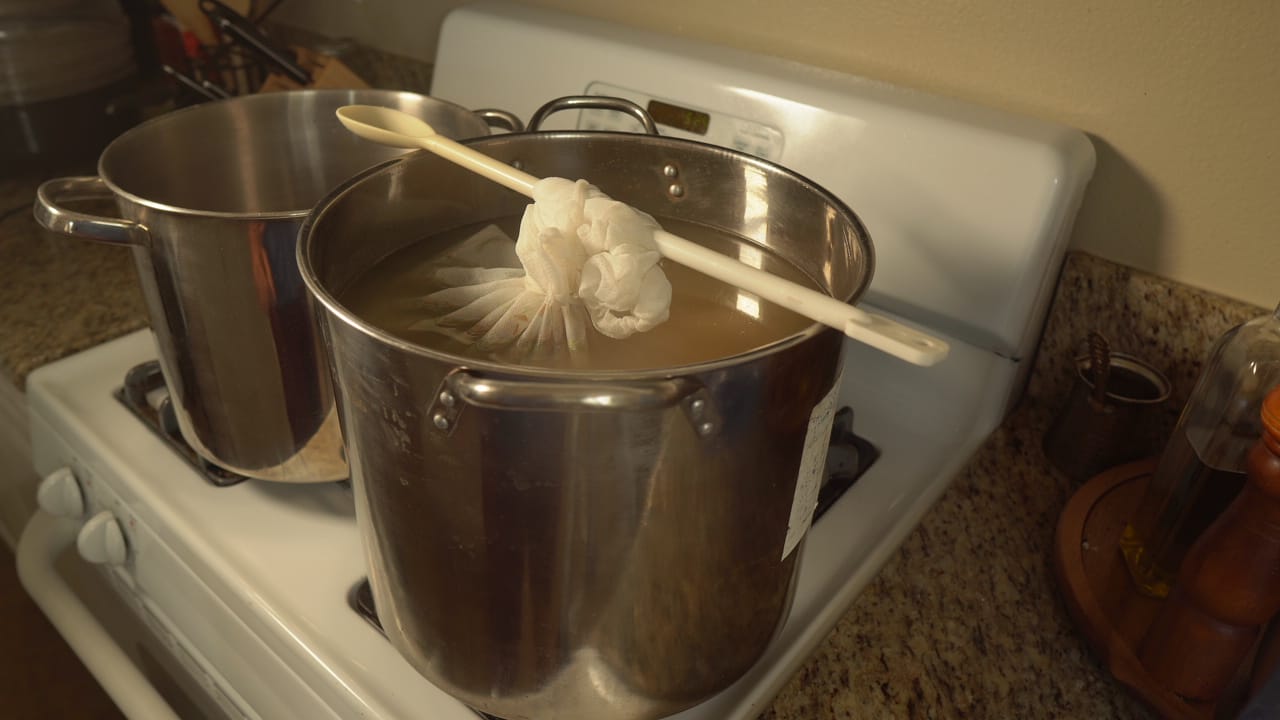 This is a crash course in beer making. The tradition of fermentable beverages goes back thousands and thousands of years to the most ancient of historical records. The information written about the process of fermentation, the science, and the ways it can go wrong or be tweaked here and there to render differing results are too numerous to capture in a single video, book, volumes of books, or even a library. If you are looking for fine details about brewing with lots of calculations, charts, and diagrams, this is not for you. If you want to understand the basic concepts of beer brewing and fermentation with yeast, accepting that results can wildly vary, this is the video for you. Even condensing this into the most concise details as possible, this is still going to be a long video, but I will cover what you need to know, from the equipment, mash, hops, yeast, how to know it’s done, how to clear it, bottle it, and even a little about the history of beer. It’s much to cover, but it should provide anyone with a strong basis for further research. Let’s get started making this City Prepping Strong Brown Ale.
This is a crash course in beer making. The tradition of fermentable beverages goes back thousands and thousands of years to the most ancient of historical records. The information written about the process of fermentation, the science, and the ways it can go wrong or be tweaked here and there to render differing results are too numerous to capture in a single video, book, volumes of books, or even a library. If you are looking for fine details about brewing with lots of calculations, charts, and diagrams, this is not for you. If you want to understand the basic concepts of beer brewing and fermentation with yeast, accepting that results can wildly vary, this is the video for you. Even condensing this into the most concise details as possible, this is still going to be a long video, but I will cover what you need to know, from the equipment, mash, hops, yeast, how to know it’s done, how to clear it, bottle it, and even a little about the history of beer. It’s much to cover, but it should provide anyone with a strong basis for further research. Let’s get started making this City Prepping Strong Brown Ale.
///
WHAT YOU WILL NEED
You will need a few primary ingredients and equipment in your beer kit. I will explain each throughout the process,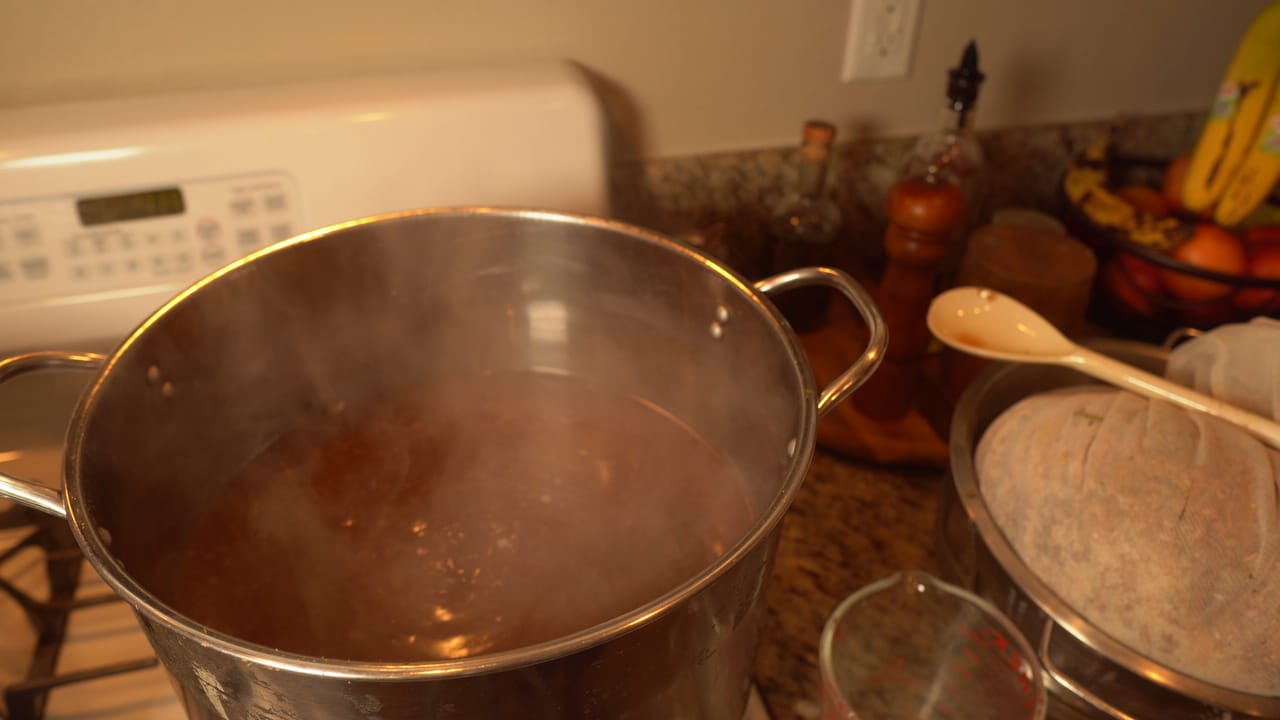 so you may determine if you need to substitute or find alternatives to these basics. You will need a container capable of holding 5 gallons for this batch. I will use a water carboy. You will need a bubbler for the top to keep air out but allow the escape of C02. You could also attach a rubber glove with a pinprick hole in one of the fingertips for the same effect. You will need at least one large pot capable of holding 5 gallons or 20 quarts. I will use two pots to reach an appropriate volume of just under 5 gallons and demonstrate the use of all grain brewing versus liquid extract brewing. Typically, you are doing one or the other and not both.
so you may determine if you need to substitute or find alternatives to these basics. You will need a container capable of holding 5 gallons for this batch. I will use a water carboy. You will need a bubbler for the top to keep air out but allow the escape of C02. You could also attach a rubber glove with a pinprick hole in one of the fingertips for the same effect. You will need at least one large pot capable of holding 5 gallons or 20 quarts. I will use two pots to reach an appropriate volume of just under 5 gallons and demonstrate the use of all grain brewing versus liquid extract brewing. Typically, you are doing one or the other and not both.
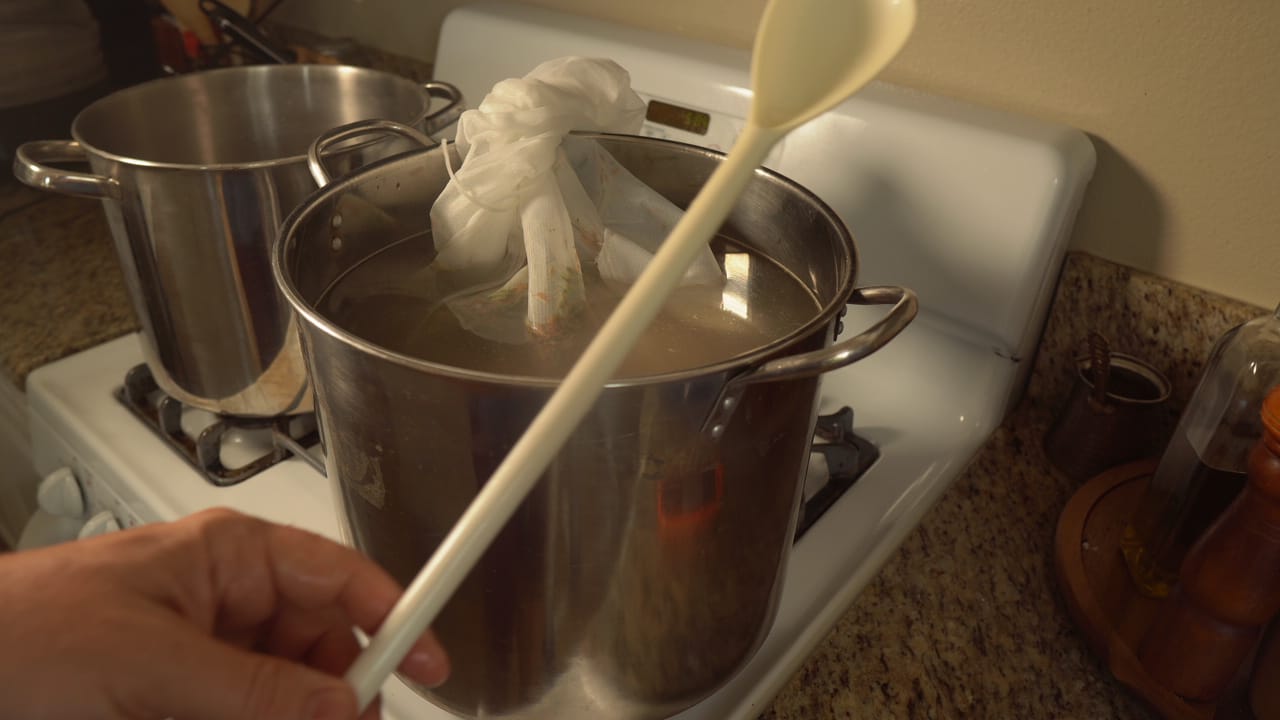 Additional equipment includes a stirrer, funnel, wire mesh strainer or nylon bag, measuring cup, a thermometer of some kind, and plastic cling wrap. Optionally, you might also want a hydrometer, which I will explain later, and here I will try a nylon grain bag, which I haven’t used before.
Additional equipment includes a stirrer, funnel, wire mesh strainer or nylon bag, measuring cup, a thermometer of some kind, and plastic cling wrap. Optionally, you might also want a hydrometer, which I will explain later, and here I will try a nylon grain bag, which I haven’t used before.
Here is a good brew supply store. For your ingredients, you will need water, yeast, grain or liquid malts, hops, and any extra sugars you plan on adding to your beer. I will leave the amounts, boil length, and additions to you. If you want to follow this recipe, I will include a comprehensive ingredient list on the website at cityprepping.com/beer. I will leave up to you what’s in your beer, but some other possible additions are additional sugars, spices, and clarifiers. I am going to use some date sugar and a clarifier in mine.
DO THE MASH
Mash is the grains used in beer when treated with the water used for the beer. It may look like simple oats, barley,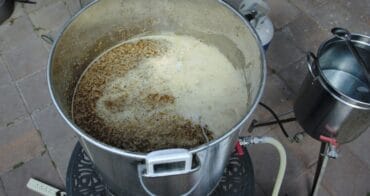 sorghum, wheat, millet, maize, or even cassava root, but your grain bill, as it is called, is alive with starches, saccharified sugars, and enzymes ready to break down those starches to simple sugars that yeast will thrive upon. If you are using the grain you harvested, you will need to sprout it slightly first. This starts the breakdown of the starches and releases the nutrients. If you are buying malted grain, this step has been done for you. An all-grain recipe will require 8-15 pounds of grain.
sorghum, wheat, millet, maize, or even cassava root, but your grain bill, as it is called, is alive with starches, saccharified sugars, and enzymes ready to break down those starches to simple sugars that yeast will thrive upon. If you are using the grain you harvested, you will need to sprout it slightly first. This starts the breakdown of the starches and releases the nutrients. If you are buying malted grain, this step has been done for you. An all-grain recipe will require 8-15 pounds of grain.
For an all-liquid malt extract beer, the process of malting and extraction from the grain has already been done for you. The result is either a dark honey-like liquid with a grain biscuit taste, or it is dried into a powder. You will need at least a pound of liquid malt per gallon of beer. If you are using all liquid malt, you can add it and start your boil. If you are using any grain, you must follow a mash schedule, essentially slowly raising the temperature of the soaking grains, holding the temperature stable for some time, then washing them clean with hot water at the end. This mash schedule, as it is called, allows the main enzymes the time to break apart the long stands of starch into simple sugars that the yeast can eat to make your beer. Failure to follow a mashing schedule for grains will still give you a beer, but it won’t be very complex, and the yeast will not be able to feast like they need to. I should let you know here, too, that failing to boil for a full 60 minutes will result in specific components of your beer not breaking down. The result will be a bitter beer that isn’t very tasty or even drinkable.
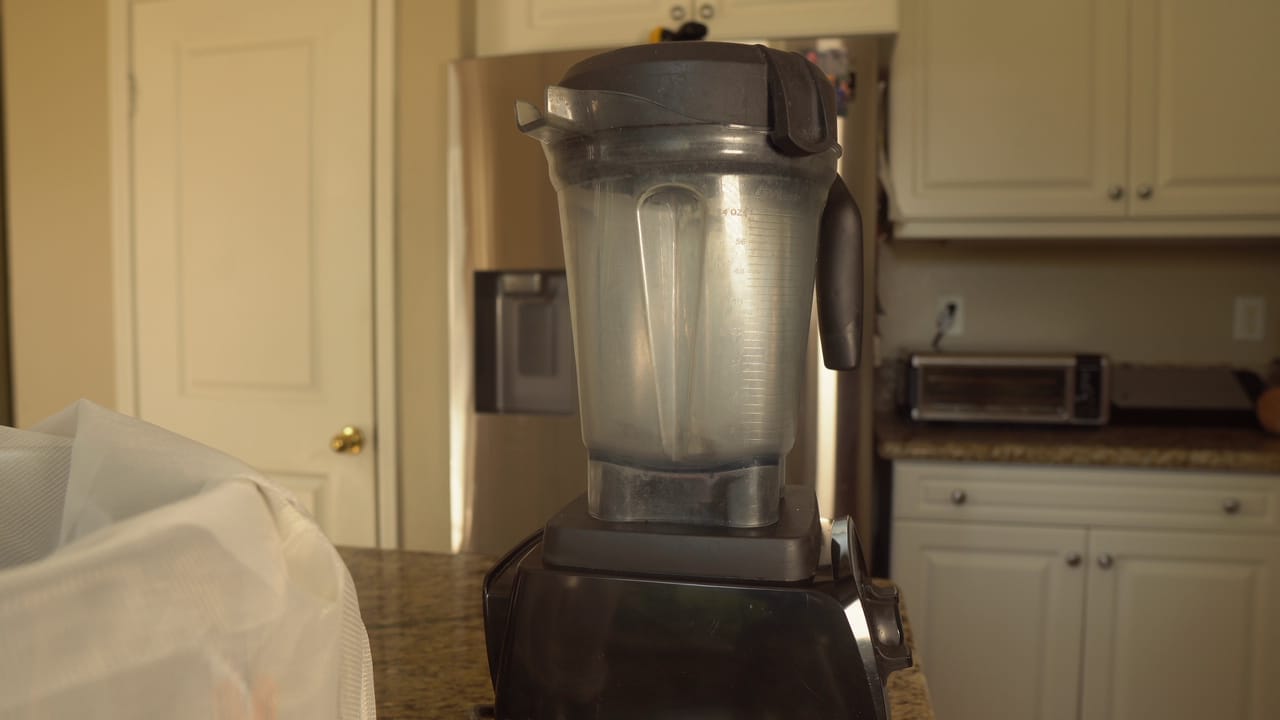 For these grains, I will follow a simple mash schedule. I have to break the hull of the grain first by gently pulsing it in my food processor. This will provide access to the nutrients locked inside. I will first raise the water temperature on the soaking grains to 104 to 113 degrees for 20 minutes. This allows the phytase enzyme present in the grain to break down an organic phosphate to yield a mild acid. The 20 minutes ensures that enzymes are well distributed within the mash and that the grain is wetted, providing access to the enzyme to the starch. In addition, this is a suitable temperature for breaking down beta-glucans, which can gum up the mash, leading to a stuck run-off or hazing up your beer. In this batch, I am using a pound of rice hulls. You could use chaff from the grain you grow for the same result, but this prevents the mash from sticking together like a big ball of oatmeal or something. This allows for the water to circulate around the grain. I am also using some homegrown oats, chaff and all, for the same reason of circulation. With grain, you are basically making a long and slow tea.
For these grains, I will follow a simple mash schedule. I have to break the hull of the grain first by gently pulsing it in my food processor. This will provide access to the nutrients locked inside. I will first raise the water temperature on the soaking grains to 104 to 113 degrees for 20 minutes. This allows the phytase enzyme present in the grain to break down an organic phosphate to yield a mild acid. The 20 minutes ensures that enzymes are well distributed within the mash and that the grain is wetted, providing access to the enzyme to the starch. In addition, this is a suitable temperature for breaking down beta-glucans, which can gum up the mash, leading to a stuck run-off or hazing up your beer. In this batch, I am using a pound of rice hulls. You could use chaff from the grain you grow for the same result, but this prevents the mash from sticking together like a big ball of oatmeal or something. This allows for the water to circulate around the grain. I am also using some homegrown oats, chaff and all, for the same reason of circulation. With grain, you are basically making a long and slow tea.
After 20 minutes, I raise the temperature to 120 to 130 and hold it there for another 20 minutes. The rest in this temperature range allows the protease and peptidase enzymes the time to cut larger starch chains into smaller bits and to break down proteins and peptides. After this 20-minute phase, I raise the temperature again to between 148 and 155 degrees for another 20 minutes to allow the beta and alpha-amylase enzymes a chance to work on breaking the grain water all down into digestible sugars for the yeast. Periodically, because I am using a nylon bag, I continually dip it in and out of the water like a tea bag. If I were to allow the grains to float freely in the water, I only need a method for filtering them out of my final liquid and a means to stir it all. After this final temperature, I want to raise the temperature to 168 to 170 for ten minutes, stirring or dipping like a tea bag to denature the enzymes and shake off any remaining sugars or starches from the grain. If I were to pour boiling water over the grains for this part, it would be called sparging the grains. The spent grain can be cooked into bread, biscuits for dogs, or added to your composter.
WORTS AND ALL
At the end of the mashing phase, you are left with what is called wort. This will become your beer. You must boil it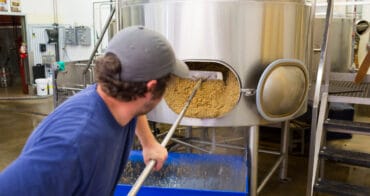 for at least 60 minutes to thermally decompose it further. If you don’t, you will have high levels of S-methyl methionine. Without getting too technical here, suffice it to say that failing to boil for at least 60 minutes will result in a bitter beer that may taste bad and have a strong sulfur smell. I know because I have made that beer. Don’t skip the boil. Don’t shorten the boil. It’s an essential part of brewing. If you are using all liquid malt, you can skip the mashing schedule and simply bring water to a boil, turn the flame off and add your liquid or powdered malt extract. Then, boil for at least 60 minutes.
for at least 60 minutes to thermally decompose it further. If you don’t, you will have high levels of S-methyl methionine. Without getting too technical here, suffice it to say that failing to boil for at least 60 minutes will result in a bitter beer that may taste bad and have a strong sulfur smell. I know because I have made that beer. Don’t skip the boil. Don’t shorten the boil. It’s an essential part of brewing. If you are using all liquid malt, you can skip the mashing schedule and simply bring water to a boil, turn the flame off and add your liquid or powdered malt extract. Then, boil for at least 60 minutes.
To this wort, you will add any hops, herbs, or additional ingredients throughout the boil.
HOP TO IT
So, you have to understand that the use of hops in beer is relatively new in beer’s history. Hops likely originated in China, but the first documented use was in the 8th century when Benedictine monks used them for brewing in a 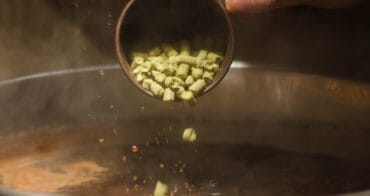 Bavarian abbey outside Munich, Germany. Before hops, beer was flavored and preserved with gruit, a combination of heather, mugwort, and other locally grown herbs and spices. Over hopping like many IPAs on the market today, started with good intentions– trying to make beer that would transport over long distances, but it has become a little too crazy, in my opinion. There are many beers on the market today that are undrinkably hoppy. In my opinion, the over-hopping trend is a method used by beginning brewers to try and make bad-tasting batches of beer drinkable. Still, hops are essential to modern beer. I will assume that you like a slight hoppiness in your beer. For my batch, I will be using just 3 ounces of hops.
Bavarian abbey outside Munich, Germany. Before hops, beer was flavored and preserved with gruit, a combination of heather, mugwort, and other locally grown herbs and spices. Over hopping like many IPAs on the market today, started with good intentions– trying to make beer that would transport over long distances, but it has become a little too crazy, in my opinion. There are many beers on the market today that are undrinkably hoppy. In my opinion, the over-hopping trend is a method used by beginning brewers to try and make bad-tasting batches of beer drinkable. Still, hops are essential to modern beer. I will assume that you like a slight hoppiness in your beer. For my batch, I will be using just 3 ounces of hops.
Here, like the mash schedule, you need a hop schedule. As you boil the hops, bittering agents are released, but the floral components and lighter flavor notes are reduced. Hops are listed by their bittering capability. If you add them at the beginning of your boil, you will extract all the potential bittering components but lose all lighter smells and tastes. This is why, just like the mash, you want a hop schedule. I add an ounce at 30 to 45 minutes into the boil. I add another ounce in the last 15 minutes of the boil, and I add the final ounce when I turn the heat off and I put the lid on the pot to allow it to cool. Just like a cook layers flavors in their cooking by adding spices and herbs at different points, the same is true for the addition of hops. By varying the types of hops and the amount of time you boil them, you are adding different levels of bitterness and flavors to your finished beer.
For my hop schedule, you can take a look at the complete recipe at cityprepping.com/beer, but I will leave your hop schedule up to you. Remember, the longer the boil, the more bittering acid in the beer. The shorter you boil them, the more floral and nuanced flavors. For the best-tasting finished beer, you need a little of both.
CHILL OUT
Different yeasts like to work at different and specific temperature ranges. Too hot, and the yeast will die or give off flavors that you won’t want in your beer. Too cold, and it will go dormant and stop working altogether or work too slowly. So, the addition of the yeast is best done at room temperature, in my opinion. I also like to make sure the yeast is working by proofing it. To do this, I pull off a couple of cups of wort from the boil about 30 minutes into the boil. I cover that with cling wrap and let that come all the way down to room temperature before adding the yeast packet or liquid yeast. You will be able to see, after an hour or more, the anaerobic activity of the yeast, maybe even some movement.
yeast is working by proofing it. To do this, I pull off a couple of cups of wort from the boil about 30 minutes into the boil. I cover that with cling wrap and let that come all the way down to room temperature before adding the yeast packet or liquid yeast. You will be able to see, after an hour or more, the anaerobic activity of the yeast, maybe even some movement.
The other reason to do this, beyond just proving that your yeast is alive, is that it gives those yeast cells a chance to wake up, feast, and multiply. This provides you with millions more hungry yeast cells to devour the sugars in your cooled wort when that time comes. This will allow them to work faster on eating up the sugars and will also then protect your beer from other contaminants that will also enjoy feasting on those sugars. While that proof is setting up and my boil is complete, I can turn the fire off, put the lid on and let the wort sit in its pasteurized environment while it comes down to room temperature. I could also set it in a bath of ice or cool stream to bring it down in temperature more quickly and to let any solids settle to the bottom of the pot.
I can pour it into my brewing container when it is completely at room temperature. Often, the brewing container is a 5-gallon bucket with a spigot and lid affixed with a bubbler. I use that to transfer my wort into the carboy. I could also use a funnel to get the wort in the container. Once it is all in the container, some people top it up with water to the amount they want. I don’t recommend that because I don’t think the flavors come together that way, and you end up with a watery-tasting beer. Plus, you risk introducing contaminants to your beer. If you believe you are under the desired amount after you boil off your initial amount, add water into the last few minutes of the boil cycle before your final hops, and bring it to a boil again.
If I do top up at all, I typically use spring water to get as natural as possible, so I don’t have to worry about the city adding any unwanted chemicals into my brew. You don’t have to, and that’s one of the reasons you boil it all, so here I am, starting with a base of city tap water and then adding in spring water. There are volumes of literature on pH and how that will affect your brewing, and I’m not going to cover any of that here. Suffice it to say, chill out, let it all cool down until you add your yeast– also called pitching your yeast. Then affix your airlock bubbler or rubber glove and wait.
WHEN IS IT DONE?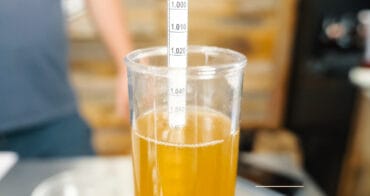 You will know it is fermenting because the yeast eats the sugar and expels carbon dioxide. That’s the bubbles in your beer. You will also see a layer of heady bubbles on the top of your brew if you can see it. That is termed the krausen or barm. This krausen is the reason you want to leave some headspace in your brew container. Some yeasts are top feeders, and some are bottom feeders, which will be a significant factor in the amount of krausen on your beer. When the yeast is really active, you will see carbonation and material moving through your beer. After this very active period, when most of the fermentation is completed, you will have to determine when your fermentation is complete enough for bottling.
You will know it is fermenting because the yeast eats the sugar and expels carbon dioxide. That’s the bubbles in your beer. You will also see a layer of heady bubbles on the top of your brew if you can see it. That is termed the krausen or barm. This krausen is the reason you want to leave some headspace in your brew container. Some yeasts are top feeders, and some are bottom feeders, which will be a significant factor in the amount of krausen on your beer. When the yeast is really active, you will see carbonation and material moving through your beer. After this very active period, when most of the fermentation is completed, you will have to determine when your fermentation is complete enough for bottling.
There are a couple of ways to determine when your beer is done and ready to bottle. I have found over time that a good rule to follow is to wait at least two weeks after the most visible fermentation has stopped. That’s two weeks after your bubbler has almost entirely stopped. After two weeks, you may see a layer of sediment forming at the bottom of your brew container. This is called the lees. Essentially, the yeast completes its consumption of all the sugars that it can, then falls to the bottom of the container in exhaustion. It isn’t necessarily dead at this point. It has attenuated or eaten all that it can, and then the alcohol level became too high, or the nutrient or oxygen level became too low, and it went to sleep. Many people find out that the yeast is dormant and not dead by bottling at this point. This will result in little bombs.
Some say you should pour it off the lees to a secondary fermenter, and that’s an excellent practice for quality beer brewing, but it isn’t entirely necessary. The thing about the lees is that as the yeast eventually does die, they impart off-flavors and stringent, bitter qualities to the beer. If you are waiting the two weeks, as I suggest, you are between the yeast dying off and the yeast mainly having finished converting the sugars to alcohol. You could, at this point, as they do in winemaking, chemically kill all the yeast. You could pasteurize the bottles to kill off the yeast, but you will end up with a flat beer.
The only accurate way you can calculate when your beer is indeed done fermenting is to take what is called a gravity reading at the beginning of the process, right before you add the yeast, and a few measurements each day after you think it is done. This is done by pouring off a small amount, usually a cup or two, and using a hydrometer. Do not pour this sample back into your brewpot. This instrument is used to determine specific gravity. It operates based on the Archimedes’ principle that a solid body displaces its weight within a liquid in which it floats. For our purposes, it’s measuring the elements heavier than water in relation to the alcohols, which are lighter than water. This is also the only accurate method for determining alcohol by volume. The approximate alcohol by volume (ABV) of the beer by subtracting the original gravity (OG) from the final gravity (FG) and multiplying it by 131. Most 5% beers have an original gravity of 1.050. Because I used grain, liquid malt extract, and the added date sugar, my batch is pretty strong and will be a challenge for the yeast.
In my case, my first reading was a very high 1.090. After a week, the gravity reading was 1.013. Doing the calculations, this beer is a little over 10%. It’s going to be strong. Over the next week, it will tick down a little more to make this batch around 11%.
CRASH IT
Your beer may still have a haziness, especially if you use fruit. There are several methods to remove the haze and get a clearer beer. Some of those methods start with additions to the boil. I have gone that route before. For this batch, I am going to use what is called sparkolloid powder, which is composed of basically chalk and seaweed. It’s a little more complex than that, but I am trying to keep this simple. You could also use gelatin. The goal is to change the ionization and encourage clumping, so the heavier clumps fall to the bottom of the brewing vessel. In my case, I simply need to dissolve one tablespoon of sparkalloid in one cup of boiling water for 5 minutes. When it cools a bit, I add it to the brewing container. After a few days, my beer will clear right up.
You can encourage this process or attempt to get the same results without additives by crashing it. That’s a term that means to chill your finished brew as much as possible. Either surround it with ice, drop it in an icy stream, put it out in the snow, or make room in your freezer. You want to lower the temperature as much as possible without freezing it. The result will be the heavier components falling and collecting at the bottom. You can then bottle the top clear liquid.
BOTTLE & CARBONATE IT
To carbonate your beer, you will want to slightly reawake the yeast by adding sugar to your beer. This is often done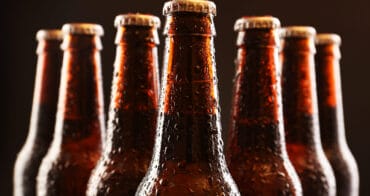 with what is referred to as priming sugar. Priming sugar is typically corn sugar or dextrose. The remaining few yeasts in the beer eat it and produce CO2, which has nowhere to go in the bottle, so it dissolves into the beer. Typically, you will use no more than 3/4 of a cup for 5 gallons. You can use other sugars, which is where science comes into play. Yeast will consume the sugars differently. If you used 3/4 of a cup of brown sugar, you would have bottle bombs. That’s probably true for white sugar too. If you were to use white sugar, it’s just 2/3 of a cup you need. A few grams of too much sugar could result in too much carbonation, so always err on the side of less. There are several online calculators to help you get this right.
with what is referred to as priming sugar. Priming sugar is typically corn sugar or dextrose. The remaining few yeasts in the beer eat it and produce CO2, which has nowhere to go in the bottle, so it dissolves into the beer. Typically, you will use no more than 3/4 of a cup for 5 gallons. You can use other sugars, which is where science comes into play. Yeast will consume the sugars differently. If you used 3/4 of a cup of brown sugar, you would have bottle bombs. That’s probably true for white sugar too. If you were to use white sugar, it’s just 2/3 of a cup you need. A few grams of too much sugar could result in too much carbonation, so always err on the side of less. There are several online calculators to help you get this right.
Dissolve the sugar in 1 cup of boiling water and add it directly to your brew at least 30 minutes before bottling to combine. Then bottle and wait another two weeks. After a week, you could check your carbonation levels by opening a chilled bottle. Eventually, the yeast will stop because the dissolved C02 level is too high or the sugars and other nutrients are too low. This is your shelf-stable sweet spot. Chill the beer you plan on drinking in the short term. Store the rest in a cool and dark temperature stable location for a later date.
UNDERSTANDING BEER
Beer is any fermented beverage made from malted grains, water, yeast, and herbal additions ranging from the modernly popular hop to spruce, pine needles, mugwort, and a host of other roots and herbs. Beer is one of the oldest and most consumed beverages on the planet. It was likely discovered by accident when an agrarian society  first began. Our ancestors settled, farmed, and drank beer. Possibly grain storage was allowed to get too wet, perhaps by soaking the grains to make them more edible in sprout form. That excess water likely spontaneously started to ferment from any one of the more than 500 species of yeasts floating around in the air. The result was alcohol. Consuming the grains or the liquids would have had a spirited effect, perhaps strong enough to lead to intoxication.
first began. Our ancestors settled, farmed, and drank beer. Possibly grain storage was allowed to get too wet, perhaps by soaking the grains to make them more edible in sprout form. That excess water likely spontaneously started to ferment from any one of the more than 500 species of yeasts floating around in the air. The result was alcohol. Consuming the grains or the liquids would have had a spirited effect, perhaps strong enough to lead to intoxication.
Thus, beer was born. Since then, different styles have emerged as a result of different methods, strains of yeast, water quality, grain variation, and hop or herbal additions. Even the addition of fruit or some honey changes the resulting beer. The same basic wort can be inoculated with different yeast strains in separate containers, and the result will be wildly different tasting beers with varying amounts of alcohol by volume. Divide the same batch with the same yeast strain and expose it to different temperatures, and you will get similar beers in color, but the taste will be far different. Beer is any fermented beverage made from malted grains, water, yeast, and herbal additions. That’s a broad range of drinks, though it sounds so simple. This is why there are so many recipes and so many styles around the world.
///
There is so much to brewing. There are so many nuances and lessons learned over the years. You have to make a few mistakes along the way to understand what you can and cannot do. For instance, much attention is given to sanitation, but I prefer clean over sanitized. Very old breweries in Germany have open fermented their vats in rooms with open windows for years. There’s no guarantee of sanitary with that. Some beers are made by simply placing the wort in a clay pot with a loose lid and putting it in a cool cave. Again, that’s not a sterile process. The main thing is keeping everything clean and then creating an environment that encourages yeast to thrive at the expense of everything else that would seek to destroy your great-tasting beer.
Hopefully, this crash course in brewing gives you the basics of how to brew a batch of beer. There’s so much that I didn’t cover, but that should be enough to get even a novice brewing. I would encourage you to try it, even if that’s a kit beer and kit equipment. You would be amazed at how flavorful homebrewed beer is compared to store-bought versions. At the very least, you can still have a cold glass of beer should the breweries ever stop producing this age-old drink. Cheers.
And, as always, stay safe out there.
///
City Prepping Strong Brown Ale
Ingredients
Pilsen Liquid Malt Extract (LME) 7.5 lbs
Pilsner Malt Grain 3 lbs
1 lb. Flaked Rice
1 lb. Rice Hulls
American West Coast Ale Yeast
German Hallertau Hop Pellets 1 ounce
Czech Saaz Hop Pellets 1 ounce
Additional 1 ounce of hops of your choice
Grain Mash Schedule
104 to 113 degrees for 20 minutes
120 to 130 and hold it there for another 20 minutes
148 and 155 degrees for another 20 minutes
168 to 170 for ten minutes
Hop Schedule
1 ounce at 30 minutes into boil (Any hop of your choice)
1 ounce 15 minutes before end of boil (Hallertau)
1 ounce at flame out (Czech Saaz)
Boil all ingredients for a minimum of 60 minutes.
Cool while covered until room temperature or cold crash it to room temperature.
Pour to brewing vessel.
Add yeast starter.

